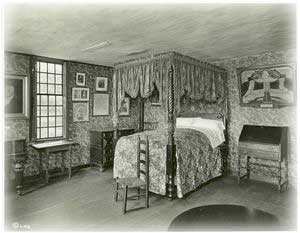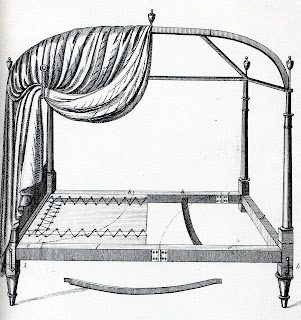At Home: The Bed
By • May 10, 2023 0 2518

The concept of the bed — a flat, horizontal spot to rest — basically stayed the same throughout history. To our earliest forebears, “bed” was a pile of leaves on a cave floor, a grass-lined pit or simply a hollowed-out place in the sand. Later, during the earliest years of colonial American settlement, the pioneers more than likely slept on the cabin floor, perhaps on a meager bit of cloth that provided some separation between them and the cold, hard ground.
Although the bed itself did not change much historically, an aspect of it that did change was who occupied it. In the days before central heating, bedmates were a necessity for warmth. Since beds were often the most expensive item in the home, few but those with means could afford more than one, so entire families sometimes shared a single bed. And if anyone were to get any rest while sleeping next to others, rules were drawn and applied. Large families assigned spots to each member according to age and gender. In wealthier households the communal beds were often elevated onto a bed frame — four turned posts of varying height held together by plain rails.

A camp bed with a laced sacking bottom. The Cabinet Directory by Thomas Sheraton, London, 1803.
Some early colonists adopted a type of bed that had been used by the poorer classes in England, known in America as the “jack bed.” It employed a post set 6 feet from one wall and 3 feet from another where fixed side rails extending to the two walls supported by slats capable of holding the bags of straw stuffed between cloth. Hence, when it was time for bed, they literally “hit the hay.”
It was during the later 1700s, that sleeping in a bed enclosed by curtains became a common way to conserve warmth. Hence, the tall-post bed with a canopy, or tester, became popular. As with many of the earliest homes in America, the main room served multiple purposes — including a living room, dining room, and a sleeping room. In smaller homes, the bed sat in the main room and with the curtains draped into elegant swags, a bedstead could become a stage for receiving guests. With the curtains closed, the bed became a snug, warm, private room within a room.
Generally, privacy in pre-industrial America was in short supply until the mid-1800s. The Industrial Revolution introduced the concept of the bedroom as a private space for sleep and became popular throughout all classes of society. During this time, metal bedsprings to support the mattress replaced ropes or wool straps. While these gave more support and stability to the mattress, they were also annoyingly squeaky.
However, the real end of allowing family, friends or strangers under the covers finally came with the Victorians. Theirs was a devout era that placed great emphasis on marriage and chastity and when a bedroom used for anything other than sleeping was deemed immoral. Also, during this period there was an even greater reason for discriminating among random bedmates — disease. Among the common anxieties about public health, it was thought that a sleeping body was a prime vector for sickness. As noted in a newspaper article of the time, “air which surrounds the body under the bed clothing is impregnated with the poisonous substances which have escaped through the pores of the skin.”

Some early colonial beds were bedecked with wool, linen, and patchwork to provide some privacy and to protect the occupants from drafts. Photo from International Styles.
Social changes during the late 19th-century included a new level of autonomy for the wife within marriage and sexual boundaries within the middle-class bedroom were redrawn. Separate beds, known as twin beds, marked equality between the couple where the woman was not always as available to her husband as she had been in the single bed. After a good, long run for twin marital beds, just after WWII, there was a greater emphasis on family togetherness when working wives returned to the home. Then the twin bed was seen as dividing the couple where they needed to be most intimate, mothballing the idea of twin beds for couples.
Bed innovations proliferated during the 20th century, but the changes were primarily about the mattresses themselves, rather than the actual form of the bed. The full, queen and king size mattresses, and even the California king mattress, provided options for those desiring more real estate at rest than was offered by the twin bed mattress.
During the mid-20th century, the murphy bed and the waterbed were both invented. But the two most common types of mattresses today — innerspring and memory foam — were both developed during the later 20th century.
Innerspring mattresses became very popular in the 1930s, soon becoming the mattress no others could compete with by the 1950s. This development fomented the development and use of box-spring platforms to hold the mattress, which created a more comfortable and supportive (and quieter) bed than those used in the past.
While platform beds and four-posters are still very popular styles, mattress materials have evolved to include innerspring, memory foam and air mattresses.
The pandemic and climate change will continue to affect beds and bedrooms, as Americans continue to spend increased time at home and trends and technology change. The future of our beds is, unsurprisingly, heavily tied to technology and will likely combine all the best sleep practices into one package. While NASA has determined that it will take up to 333 days to reach Mars, scientists are trying to figure out how to help future astronauts sleep comfortably for those journeys.
But, for now, the bed remains earth-bound. And, even though it has come a long way since the earliest grass-lined pits, it’s still basically a comfortable, safe and cozy spot to sleep, restore one’s energies and have, hopefully, sweet dreams through the night.
Michelle Galler is a realtor with Chatel Real Estate, representing buyers and sellers in both Washington D.C. and Virginia with in-town, as well as rural, real estate transactions. She is also an antiques dealer and columnist.

